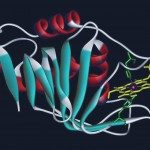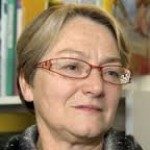Link to Pubmed [PMID] – 10848969
Eur. J. Biochem. 2000 Jun;267(12):3530-8
We examined the conformational preferences of mutants of thymosin beta4, an actin monomer sequestering protein by NMR spectroscopy in 60% (v/v) trifluoroethanol. Under these conditions, the wild-type thymosin beta4 conformation consists of an alpha-helix (helix I) extending from residues 5-16 with a more stable fragment from lysine 11 to lysine 16 and a second alpha-helix (helix II) encompassing residues 31-39. The point mutations studied here are located in helix I or in the LKKTET segment (residues 17-22) that form the two main entities of interaction with the actin molecule. The alpha-1H conformational shifts allow us to investigate the helicity of the polypeptides at the residue level and to correlate these structures with their biological activity. We determine that an extension of helix I at its C-terminal end over the LKK-segment results in loss of activity. The correct termination of this helix is connected to a specific orientation of the polypeptide essential for a cooperative action of the thymosin beta4 binding entities required for full activity.


